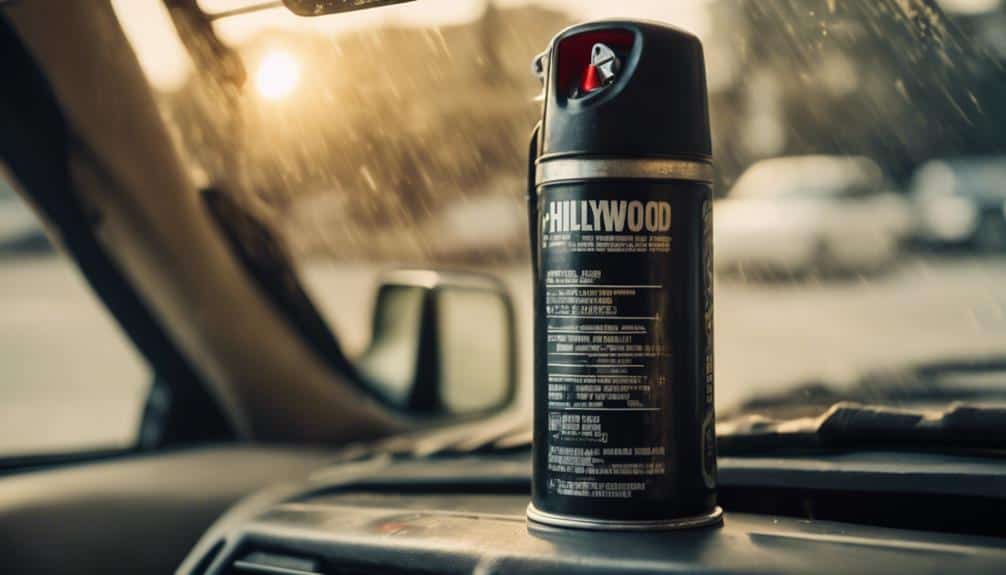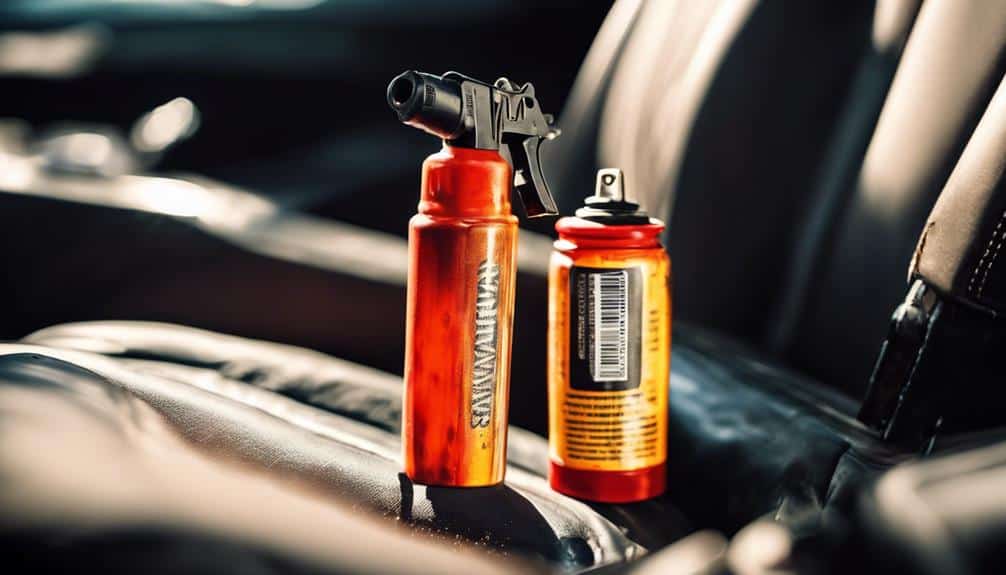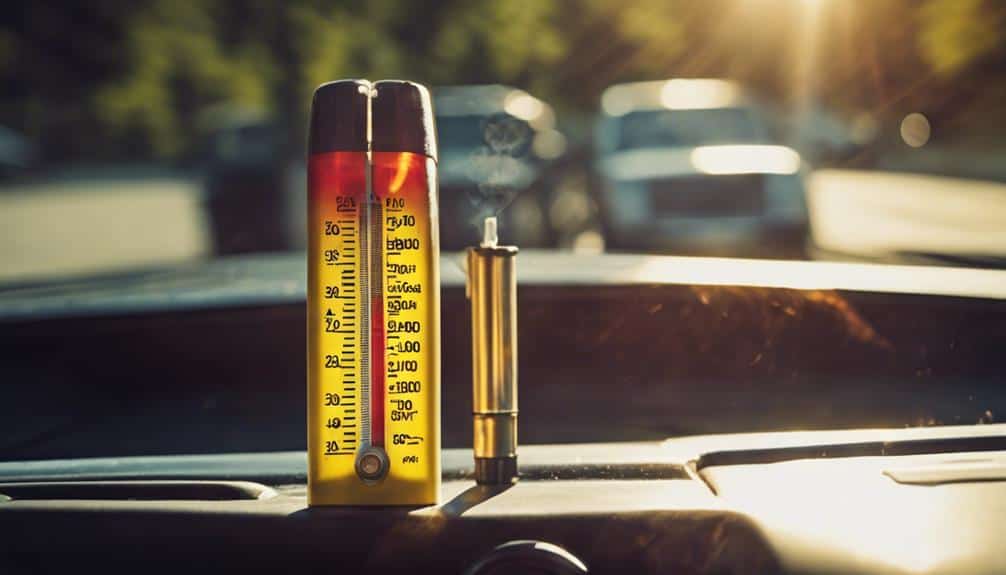Yes,
pepper spray can explode in a
hot car. Imagine this: you’re running errands on a scorching summer day, and your car feels more like an oven. Temperatures inside can easily go over 120°F, causing the
pressure in your pepper spray canister to build up dangerously. Next thing you know, it could leak or even burst, turning your car into a peppery mess, and that’s no fun at all! Chemicals in the spray might also break down, making it less effective. So, stashing it in a cool, shaded spot isn’t just smart—it’s essential. Curious about more
safety tips? Keep going!
Heat Sensitivity of Pepper Spray
Pepper spray canisters are
highly sensitive to heat, so you need to be cautious about where you store them. Imagine leaving your pepper spray in your car on a
sweltering summer day. The temperature inside a vehicle can soar well beyond the canister’s
maximum recommended limit of 120°F (48.88°C). At those temperatures, the
internal pressure of the pepper spray canister skyrockets, risking leaks or even an explosion. The
Pepper Shot 1.2% MC is designed for
effective self-defense, but exposure to high heat can render it ineffective. You definitely don’t want to open your car door to that mess!
Keeping your pepper spray effective is vital. High heat doesn’t just make it dangerous; it can also degrade the active ingredients. If you ever need to use it for self-defense, the last thing you want is for it to be a dud. To avoid this, don’t leave your pepper spray in the glove compartment or other hot spots.
Regularly check your
pepper spray canisters for
signs of heat damage. Look out for any bulging or unusual changes. If it seems off, replace it. Staying vigilant guarantees, you’re prepared, and your pepper spray stays in top shape, ready to protect you when needed. Keep it cool and
stay safe!
Risks of High Temperatures
You might think leaving your
pepper spray in the car is harmless but think again! When temperatures soar past 120°F, those pressurized canisters can turn into
ticking time bombs, leaking or even exploding. The stylish design of products like the
Pink Mace Keyguard® Pepper Spray doesn’t mean they are immune to heat hazards. Imagine coming back to your vehicle only to find it smelling like a
spicy disaster zone—definitely not the kind of surprise anyone wants.
Pressurized Canister Hazards
Summer heat can turn a car into a
dangerous environment for
pressurized canisters like pepper spray. Imagine leaving your pepper spray in the car on a
scorching day. The temperatures inside can skyrocket, exceeding 120°F (48.88°C). When this happens, those handy little cans can become
potential grenades. The
Wildfire 1.4% MC Pepper Spray is designed to provide effective self-defense, but its pressurized canister is vulnerable in extreme heat.
Why? Because pepper sprays are pressurized.
High heat causes the contents to expand, and when they do, the
risk of leaks or ruptures goes through the roof. Think of a balloon left in the sun, slowly stretching until—bam! —it pops. Except, in this case, it’s not just air; it’s a potent chemical that you definitely don’t want all over your car or, worse, your skin and eyes.
Leaving pepper spray in direct sunlight or inside a hot vehicle is like playing with fire. Prolonged exposure to high temperatures can weaken the canister’s integrity, almost like how plastic becomes brittle after too much sun. You’re not just risking a mess; you’re risking your
safety. So, next time you’re tempted to leave your pepper spray in the car, think twice. Avoid those
summer heat hazards and keep it cool!
Temperature-Induced Failures**
Under
extreme heat conditions,
pressurized canisters like those containing pepper spray are susceptible to
temperature-induced failures. Consider leaving your pepper spray in the car on a scorching summer day. The temperature inside can skyrocket past 120°F (48.88°C), turning your car into a
ticking time bomb!
Now, envision this: the heat causes the pepper spray canister to expand, pushing it to its limits. Eventually, it might burst or start leaking. Not only is this dangerous, but it also means your trusty defense tool could lose its effectiveness just when you need it most. The
chemicals inside can break down, leaving you with a canister that’s more decoration than deterrent.
To avoid this fiery fiasco, give your pepper spray a quick check, especially during those sweltering summer months. Make sure it’s not
damaged or expired. The last thing you want is to reach for it in an emergency and get a weak squirt instead of a strong spray. Manufacturers warn against storing pepper spray in your vehicle, so find a cooler, safer spot for it. Don’t let a heatwave turn your
self-defense plan into a hot mess.
User Experiences
You might think storing
pepper spray in your car is no big deal, but some users have had mixed experiences. While a few folks have kept it there for ages without a hitch, others have faced
accidental activations and even
canister failures when temps soared. It’s important to remember that pepper spray is designed to work effectively within specific temperature ranges, and
extreme heat can compromise its integrity. Regularly checking your pepper spray and being mindful of how hot it gets could save you from a messy, unexpected surprise. For instance, the active ingredient effectiveness can be diminished if the spray is exposed to high temperatures for prolonged periods.
Extended Storage Outcomes
Extended storage of pepper spray in vehicles often yields
mixed outcomes, with
user experiences highlighting both successes and failures. Some folks have found that brands like MACE can handle the heat, staying
effective even after being left in a hot car for a long time. In fact, products like the 2 oz Steam type of Pepper Shot are designed for home use or portable carrying, which could potentially influence their performance under
temperature fluctuations. Still, users recommend checking your canister regularly, just to be safe. Imagine the frustration of needing it and finding out it’s a dud.
On the flip side, others have had less luck.
Leaks and bursts aren’t uncommon when temperatures soar, causing more than just a mess. One user shared how their bear spray, meant for a camping trip, leaked all over their trunk. Talk about a sticky situation!
To avoid these mishaps, store your pepper spray in
shaded areas of your car. Direct sunlight is a no-go. And it’s always a good idea to test your pepper spray periodically, especially after it’s been through a
scorching summer or a freezing winter.
Think of it like checking your car’s oil or tire pressure—it’s
essential maintenance. So, while some find success with
extended storage, others caution that the risks might not be worth it.
Temperature Impact Reports
Maneuvering the uncertainties of storing pepper spray in your vehicle brings us to the heart of user experiences with temperature impacts. Imagine baking summer days where car interiors can easily exceed 120°F (48.88°C); users have reported their pepper spray canisters leaking or even bursting under these conditions. It’s like a scene straight out of a suspense movie, but without the fun.
Yet, some folks have managed to store their spray in cars for ages without a hitch, swearing by their brands. So, what gives?
| User Experience |
Result |
| Left in car, 120°F+ |
Canister leaked/burst |
| Stored for long term |
No issues, no leaks or explosions |
| Extreme weather concern |
Performance affected by temp fluctuations |
| Avoid direct sunlight |
Prevented overheating and canister failure |
You might be wondering if it’s just luck or if some brands are sturdier. Turns out, not all sprays are created equal. Some hold up better in high heat, while others… not so much. It’s like comparing a marathon runner to someone who gets winded walking to the fridge.
Accidental Activation Incidents
Imagine this: you’re driving down the road, and suddenly, there’s an
eye-watering cloud of pepper spray filling your car. It sounds like a nightmare, doesn’t it? You can barely see, your eyes are burning, and you’re trying not to swerve off the road. This scene isn’t just out of a movie; it’s a real-life incident that some users have faced due to
accidental activation of pepper spray canisters. While
compact designs like the
Pink Mace Pepper Spray Jogger are tailored for active individuals, they can still pose risks if not
stored properly. People have reported that even a slight jostle or bump can trigger the release of pepper spray in their cars. You never really think it could happen until it does. Just the movement from a sharp turn or a sudden stop can lead to an
unintentional discharge. And trust me, in the confined space of a car, it’s a
serious safety risk.
Safe Storage Practices
When it comes to
safe storage practices for pepper spray, it’s important to keep the canisters in a
moderate temperature environment, ideally at room temperature. The
Pink WildFire 1.4% MC is designed for
maximum effectiveness, and
extreme heat can compromise its reliability. You’ve probably never had a problem with this, but it’s vital to avoid storing them in places where temperatures can swing wildly, like your car. In hot weather, the inside of your vehicle can become a tiny oven, reaching temperatures over 120°F, which is way above the safe limit for pepper spray.
Instead, consider keeping your pepper spray in shaded areas, like a glove compartment or under a seat. These spots can help keep the heat at bay and prevent any
accidental leaks or, worse, explosions. If you must leave it in the car, wrapping it in
protective materials can add an extra layer of insulation, giving you peace of mind.
Regularly checking your canister for any damage and noting its
expiration date is another key step. You don’t want to find out your pepper spray is past its prime when you need it most. By following these tips, you’ll guarantee that your pepper spray is always in
top condition and ready to keep you safe.
Maintaining Effectiveness
Keeping your pepper spray in
ideal condition goes beyond just safe storage. You’ve got to think about
maintaining its effectiveness too. Pepper spray canisters, like the
Mace Pepper Spray Jogger, are designed to work best within a
temperature range of 32°F to 120°F. Exposing them to temperatures outside this range, like leaving them in a hot car, can seriously mess with their effectiveness.
High heat can break down the chemicals inside, making your spray less potent when you need it most.
You should never neglect
regular testing. Every 90-180 days, give your pepper spray a quick check to verify it’s still functioning properly. This helps you avoid any nasty surprises when you need it. Also, remember to store your pepper spray away from
direct sunlight and extreme temperatures. This simple step preserves its
active ingredients, guaranteeing it remains effective throughout its
2–4-year shelf life.
Imagine the disappointment of reaching for your pepper spray in a critical moment, only to find it’s lost its punch. Don’t let that happen! Stay proactive, and your pepper spray will be ready to protect you when it counts. Keep it cool, keep it tested, and it’ll never let you down.
Legal and Safety Tips
Maneuvering the legal and safety aspects of pepper spray use is crucial to guarantee you stay within the law and protect yourself effectively. First things first, never leave your pepper spray in a hot car. Temperatures exceeding 120°F can cause it to leak or, worse, explode. Sabre Red, a popular brand, is no exception to this rule. Extreme heat can deform the canister or degrade the active ingredients, making it useless when you need it most.
You should also check your pepper spray regularly. Every 90-180 days, give it a test spray to verify it’s still functional and not damaged. Legal considerations vary, so make sure you know your local laws on carrying and using pepper spray. Ignorance isn’t bliss when it comes to safety and legality.
Here’s a handy table to keep you on track:
| Tip |
Details |
| Avoid Extreme Heat |
Don’t store in temperatures above 120°F |
| Regular Checks |
Test every 90-180 days |
| Sunlight Storage |
Keep out of direct sunlight |
| Legal Awareness |
Know your local laws |
| Brand Specifics |
Sabre Red and others have similar guidelines |
Frequently Asked Questions
Imagine a candle melting in the sun—that’s how heat affects pepper spray. It loses heat stability, degrading in effectiveness. Exposure to high temperatures can break down its active ingredients, making it less potent when you need it.
Can You Put Pepper Spray in a Car?
You shouldn’t store pepper spray in your car due to safety precautions. Extreme temperatures can cause leaks or explosions. If you must, keep it in the glove compartment, but regularly check it to guarantee it’s safe.
Will Bug Spray Explode in a Hot Car?
Coincidentally, you’re asking about bug spray, which can indeed explode in a hot car. Take safety precautions: don’t leave aerosol cans in vehicles during summer. Store them in cool, shaded areas to prevent hazardous incidents and guarantee safety.
Can Pepper Spray Burst?
Yes, pepper spray can burst. You should know that its chemical stability is compromised at high temperatures. When exposed to heat exceeding 120°F, the canister might leak or explode, creating dangerous situations. Avoid leaving it in hot cars.







